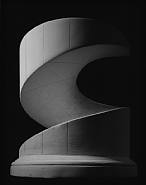 Guy Ben-Ner’s in the zone these days; his ingenious video, “Elia – a story of an ostrich chick,” made like one of those anthropomorphizing Disney nature documentaries from the 50’s, is included in PS1’s Greater NY show. Now, he’s representing Israel in the Venice Biennale.
Guy Ben-Ner’s in the zone these days; his ingenious video, “Elia – a story of an ostrich chick,” made like one of those anthropomorphizing Disney nature documentaries from the 50’s, is included in PS1’s Greater NY show. Now, he’s representing Israel in the Venice Biennale.
At Venice, Ben-Ner talks with PS1 curator Bob Nickas about his work and how he uses adaptive techniques for shooting under directorial duress. He references silent film, in which the camera couldn’t move, and nature documentaries, where you can’t direct animals. Ben-Ner uses his kids in his videos, which requires a certain creativity to get anything down on tape.
Ben-Ner’s segment lasts about 15 minutes, and then Nickas and his too-smart sidekicks spiral out of control, gushing over Vezzoli’s Caligula trailer–in exactly the critically unaware way that bugs so bad. While Ben-Ner sits silently by for the next 30-40 minutes, the curator/writer conversation encapsulates exactly the kind of hermetic, bitchy Venetian oneupsmanship that shouldn’t be recorded, much less broadcast. Don’t miss it.
WPS1 Venice Conversation – The Bob Nickas Roundtable [wps1.org, updated link to clocktower.org, July 2018]

 Sherman Sam interviews the artist Hiroshi Sugimoto about his London show at Gagosian. Sugimoto’s latest works, originally shown at the Fondation Cartier, are photographs of early 20th-century mathematical and mechanical study models from the collection of Tokyo University.
Sherman Sam interviews the artist Hiroshi Sugimoto about his London show at Gagosian. Sugimoto’s latest works, originally shown at the Fondation Cartier, are photographs of early 20th-century mathematical and mechanical study models from the collection of Tokyo University.